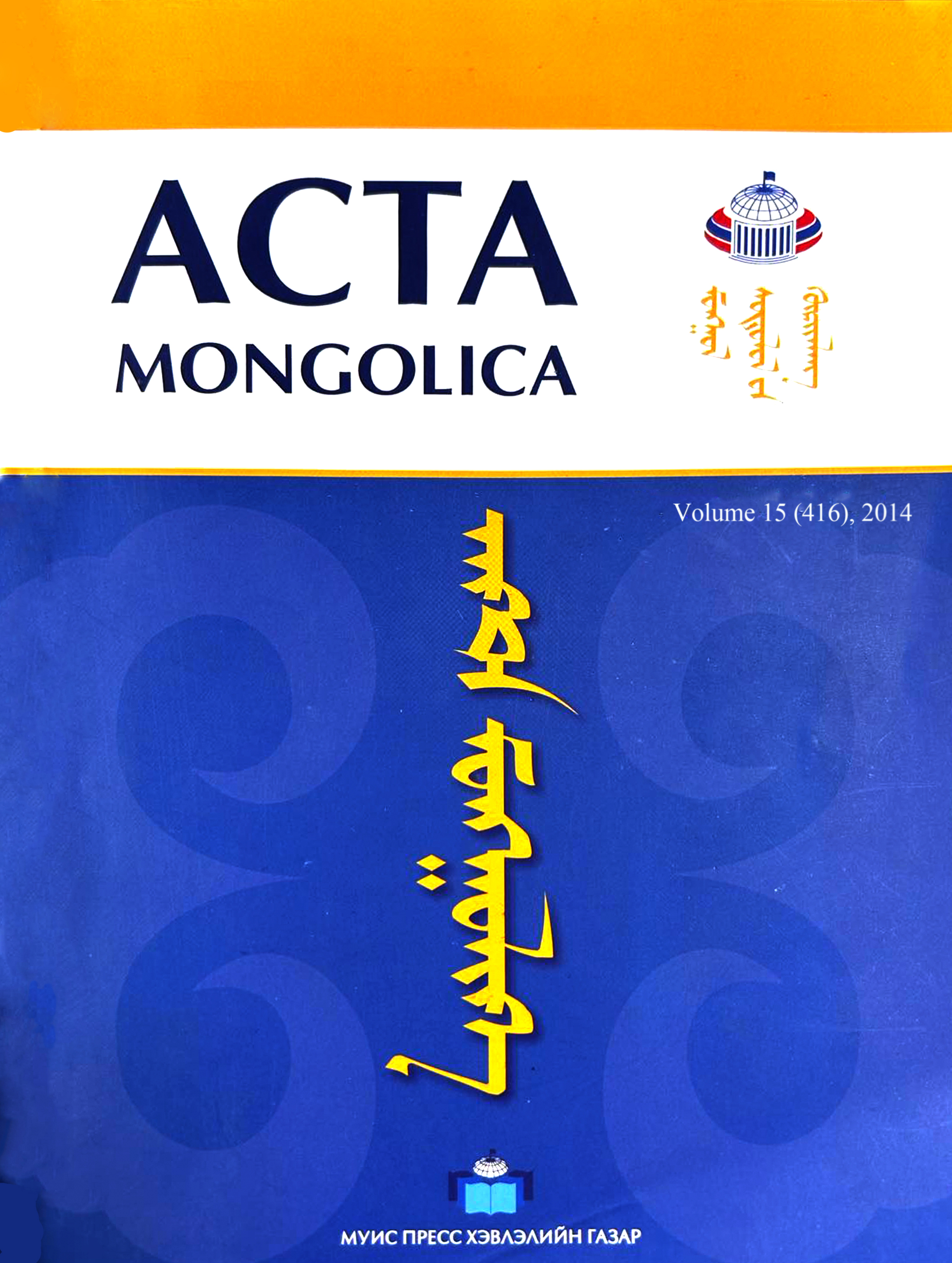Mongolian Tolerance and Intolerance Toward Different Cultures An Exploration Based on Analyses of Cross-National Survey Data
Main Article Content
Abstract
The rise and rampancy of ultranationalists has been repeatedly reported in Mongolia in recent years, but whether views and actions characterized by ultranationalism are prevalent remains to be determined. Some insist that ultranationalists are gaining in popularity, and others deny that such groups represent the majority of the Mongolian people. However, the grounds of these arguments are unclear. To elucidate this question on an empirical basis, I examined how tolerant and intolerant Mongolians are to people of different cultural backgrounds based on statistical analyses of cross-national survey data. A comparison among post-socialist countries reveals that although people with intolerant attitudes toward those from different cultures remain in the minority in Mongolia, the percentage of such people is relatively high compared with other post-socialist countries; in particular, a negative attitude toward foreign workers and immigrants is clearly observed. The result demonstrates the potential risk of the spread of exclusivism in Mongolia.
Article Details

This work is licensed under a Creative Commons Attribution-ShareAlike 4.0 International License.
References
*Ritsumeikan University (Kyoto, Japan) Tania Branigan, “Mongolian Neo-Nazis: Anti-Chinese Sentiment Fuels Rise of Ultra-Nationalism,” The Guardian, August 2, 2010,
http://www.guardian.co.uk/world/2010/aug/02/mongolia-far-right; and Chris Hogg, “Discontent Fuels Mongolia’s Far-Right Groups,” BBC News, September 6, 2010, http://www.bbc.co.uk/news/world-asia-pacific-11141472 2 Palash Ghosh, “Mongolian Neo-Nazis Switch from Nationalism to Environmentalism by Attacking Foreign Mining Companies,” International Business Times, July 2, 2013, http://www.ibtimes.com/mongolian-neo-nazis-switch-nationalism-environmentalism-attacking-foreign-mining-companies-1331817 Carlos Barria, “Mongolia Neo-Nazis Announce a Change of Tack - Pollution Control,” Reuters, July 2, 2013, http://www.reuters.com/ article/2013/07/02/us-mongolia-rightwing-idUSBRE96108N20130702; and Graham Land, “White Swastika: Mongolia’s Eco-Nazis,”
Asian Correspondent, July 3, 2013, http://asiancorrespondent.com/110130/white-swastika-mongolias-eco-nazis/ Statement by the Mongolian historian and social scientist Nyam Puruv in Fenbo Wang and Chi Viet Giang, “Mongolian Nazis Provoke Chinese Resentment,” DW, September 15, 2010, http://www.dw.de/mongolian-nazis-provoke-chinese-resentment/a-6008069 Statement by Tal Liron, then a PhD candidate at the University of Chicago, in Barria, “Neo-Nazis Announce a Change of Tack.”
Land, “White Swastika.” Statement by Enkhjargal Davaasuren, director of the National Centre Against Violence, in Branigan, “Mongolian Neo-Nazis.” N. Graaf, “Rampant Racism a Growing Problem in Mongolia,” DW, April 17, 2012, http://www.dw.de/rampant-racism-a-growing problem-in-mongolia/a-15888287. Statement by Franck Billé of Cambridge University in Branigan, “Mongolian Neo-Nazis.”
The country has been excluded since the first LiTS due to political and social conditions. See Synovate. Life in Transition Survey (LITS) 2006: A Brief Report on Observations, Experiences and Methodology from the Survey. (Nicosia, Cyprus: Synovate), www. ebrd.com/downloads/research/surveys/litsrepo.pdf Table 2 shows the results of the responses to q3.17. Countries are listed in order of the percentage of people who indicated answers that were categorized as “yes.” Because of space limitations, only part of the results are presented here; nevertheless, from the table it is obvious that a negative attitude toward people from different ethnic groups is more common in Mongolia than in other PSCs. The results of comparing the items on a different culture are shown in Table 3. The percentage of people who selected groups of people of different cultures was relatively high in Mongolia and exceeded the mean score of all PSCs. In particular, the percentage who selected “immigrant/foreign workers” in Mongolia was the highest. Again, the results indicated a negative attitude in Mongolia toward people of different cultures. For mathematical background and a description of the practice of MCA, see Michael Greenacre and Jörg Blasius, eds., Multiple
Correspondence Analysis and Related Method (Boca Raton, FL: Chapman and Hall/CRC, 2006); and Michael Greenacre, Correspondence Analysis in Practice (Boca Raton, FL: Chapman and Hall/CRC, 2007).
Responses to the three variables were reorganized into three categories as shown in Table 2.
There were four categories to describe educational attainment. “None/primary” included respondents with either no education or primary or lower secondary education. “(Upper) Secondary” consisted of those with secondary education. “None-tertiary” indicated those with post-secondary education but not tertiary. Respondents with a bachelor’s degree or above were classified as “tertiary.”
Respondents’ residences were sorted into the following three categories along with the primary sampling units: “Metropolitan” (the capital city Ulaanbaatar), “city” (Local cities including Darkhan-Uul aimag, Orkhon aimag, and other aimag centers), and “rural” (other sampling units).
The respondents were asked to rank their present income on a 10-point scale. Answers from 1 to 4 were categorized as “low,” 5 and 6 were categorized as “middle,” and 7 to 10 were categorized as “high.”
The occupational status of the respondents was classified, on the basis of their primary job, as “upper white” (managerial and professional jobs), “lower white” (clerical and sales jobs), “blue” (manual labor), “agriculture,” and “not working.”
The reason for this might be that there were very little number of people whose main job is “Agriculture.” They comprised less than 1% of the respondents in Mongolia.
Mongol Ulsyn Ündesnii Statistikiin Khoroo, Khün am, oron suutsny 2010 ony ulsyn toologo.(Ulaanbaatar, Mongol Ulsyn Ündesnii Statistikiin Khoroo, 2011), p.28.
Ishida Koichiro, “Mongolia Looks to Japan to Get out of China’s Economic Shadow,” the Asahi Shimbun, April 1, 2013, http://ajw.asahi.com/article/asia/china/AJ201304010090
“Labor,” M.A.D. Investment Solutions, Last modified August, 2013, http://mad research.com/mongolian-real-estate-market/construction-sector/labour/

